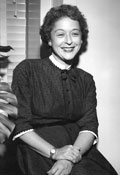Harriet Pilpel facts for kids
Quick facts for kids
Harriet Pilpel
|
|
|---|---|
 |
|
| Born |
Harriet Fleischl
December 2, 1911 |
| Died | April 23, 1991 (aged 79) Manhattan, New York
|
| Alma mater | Vassar College Columbia University Columbia Law School |
| Occupation | Attorney |
| Spouse(s) | Robert C. Pilpel (1933–1987) Irvin B. Schwartz (1989–1991) |
| Children | Judith Ethel, Robert Harry |
Harriet Fleischl Pilpel (December 2, 1911 – April 23, 1991) was an American lawyer and women's rights activist. She worked hard to protect important freedoms for people. These included the freedom of speech, which is the right to say what you think. She also fought for freedom of the press, which means newspapers and media can report freely. Another key area was reproductive rights, which is about people's choices regarding their own bodies and families.
Harriet Pilpel was the main lawyer for the American Civil Liberties Union (ACLU). This group works to protect the rights of all Americans. During her career, she was involved in 27 cases that went to the Supreme Court of the United States. This is the highest court in the country.
About Harriet Pilpel
Early Life and Education
Harriet Fleischl was born on December 2, 1911. Her parents were Julius and Ethel Fleischl. She grew up in the Bronx, a part of New York City. Harriet had two younger sisters, Juliette and Ruth.
She was a very good student. In 1932, she graduated from Vassar College. The next year, in 1933, she earned a master's degree from Columbia University. She studied public law and international law there. Harriet then went to Columbia Law School. She earned her law degree in 1936 and was one of the top students in her class.
Her Work as a Lawyer
Harriet Pilpel was a very influential lawyer. She worked on many important cases. Her ideas and writings were often used by the Supreme Court of the United States. They were also discussed when new laws were being made.
One law professor, Sylvia A. Law, said that Harriet was a "brilliant legal tactician." This means she was very smart at planning legal strategies. She understood the details of the law very well. She also knew a lot about public opinion and how different groups thought.
Harriet Pilpel was a student and colleague of Morris Ernst. He was one of the people who helped start the ACLU.
In 1952, Harriet Pilpel co-wrote a book called Your Marriage and the Law. She also helped writers and publishers with their legal issues. This included cases about copyright law. Copyright law protects who owns creative works like books or songs.
She represented many famous people. These included writers like Betty Friedan and Edna Ferber. She also worked with entertainers like Mel Brooks. In 1965, she represented a famous doctor named Benjamin Spock. This case was about whether advertisements in his book violated his free speech rights.
In 1973, Harriet Pilpel spoke to the International Council of Women. She talked about the legal rights of young people.
During the 1960s, she was part of the Presidential Commission on the Status of Women. This group advised the presidents Kennedy and Johnson. From 1965, she also advised the United States Women's Bureau. This is part of the Department of Labor.
From 1979 to 1986, she was the main lawyer for the American Civil Liberties Union (ACLU). She also served on the boards of the Guttmacher Institute and the ACLU. She was a leader in the National Coalition Against Censorship. This group fights against limiting what people can say or read.
In the 1950s and 1960s, Harriet Pilpel wrote a monthly column for Publishers Weekly. It was called "But Can You Do That?" She also often appeared on a TV show called Firing Line.
Harriet Pilpel gave her research files to the Sophia Smith Collection at Smith College in 1982. This collection keeps important papers from women's history.

